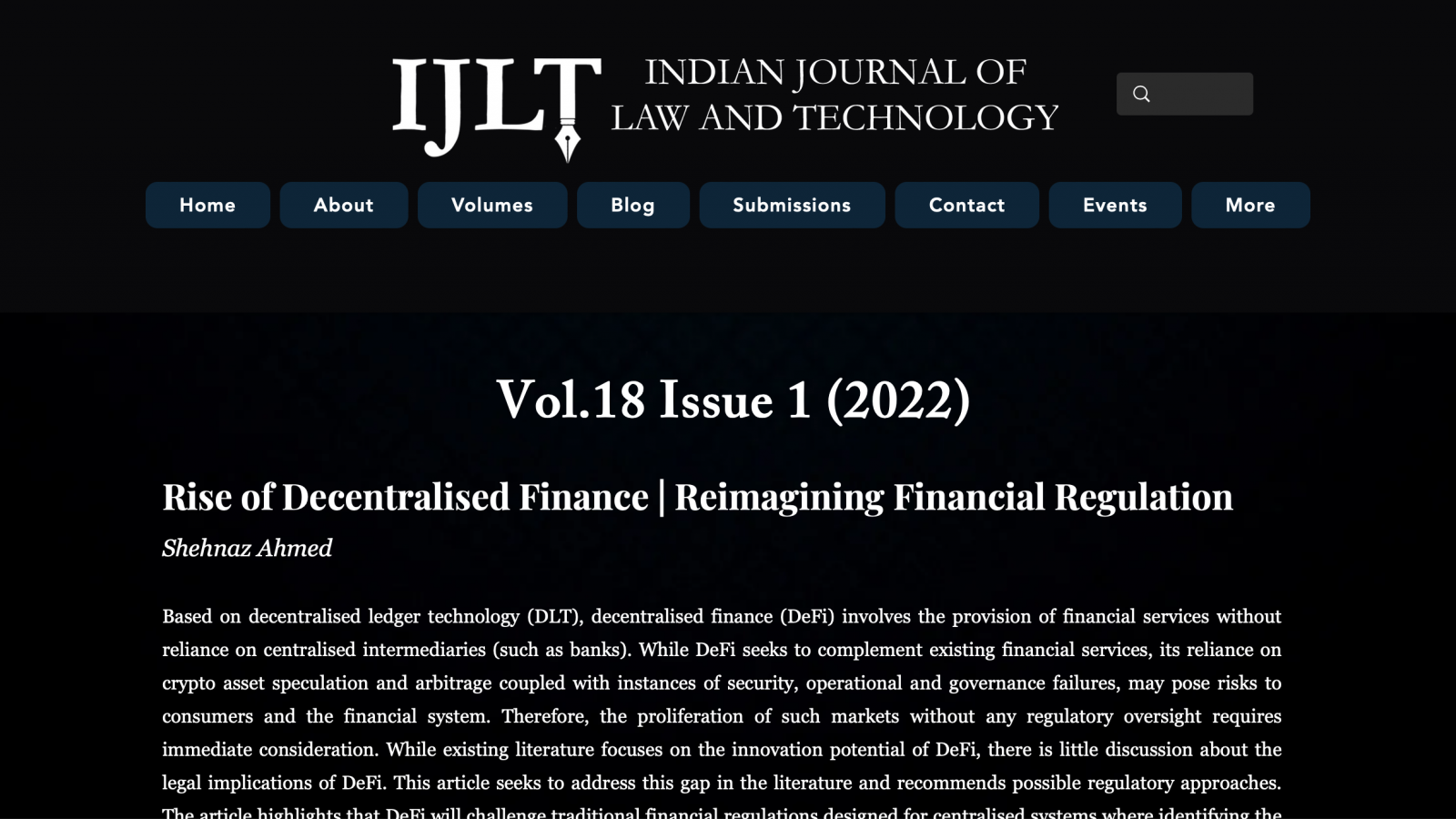
A Central Bank Digital Currency for India – Proceeding with Cautious Optimism
Summary: This working paper seeks to initiate and inform the public discourse on CBDC in India. By tracing CBDC developments in 43 countries, it seeks to analyse the preliminary considerations for a retail CBDC issuance in India
In 2020, China launched a pilot to test its central bank digital currency (“CBDC”) – a digital version of the Chinese Yuan that will be made available to the Chinese population through electronic wallets. This was followed by announcements by several countries on their CBDC projects, with the Central Bank of Bahamas announcing a national roll-out of its CBDC last October. In early 2021, the Reserve Bank of India (“RBI”) also acknowledged that it is exploring the need to issue a CBDC for India. Conversations around CBDC is not new. However, recent developments, particularly, the rise of privately issued cryptocurrencies and stablecoins and the desire to play a leading role in the global discourse on CBDC has accelerated the CBDC research in many countries.
While CBDC has the “potential to be the next step in the evolution of money”, CBDC issuance calls for cautious optimism. The novelty and complexity associated with CBDC issuance involves important questions especially its possible impact on the financial system and its stability. Against this background, Vidhi’s working paper seeks to initiate and inform the public discourse on CBDC in India. By tracing CBDC developments in 43 countries (“Surveyed Jurisdictions”), the working paper seeks to analyse the preliminary considerations for a retail CBDC issuance in India. Given the nascent stage of CBDC research, the paper does not deal with the normative question of whether India should issue a CBDC.
What is a Central Bank Digital Currency?
It is a digital version of a country’s fiat currency (such as a digital rupee, digital dollar or a digital euro) and will be made digitally available to its users. It will be issued and guaranteed by the central bank. It will be distinct from the existing central bank money that exists as banknotes and accounts held by financial institutions (mostly banks) with the central bank.
How is it Different from E-Money, Cryptocurrency and Stablecoin?
CBDC must be distinguished from the existing forms of private money such as e-money (money stored in prepaid wallets) or bank deposits, that can be transferred electronically using cards or mobile payment applications. Such money is issued by private entities i.e., banks or non-banks and are not a liability of the central bank.
Similarly, a CBDC is different from cryptocurrencies and stablecoins which are issued by private entities. Unlike CBDCs which will be a liability of the central bank, cryptocurrencies are no one’s liability and their value is derived from the expectation that they will be valued and used by others. Due to their limited use and volatility in their prices, such currencies often fail to effectively serve the functions of money.
Why are Surveyed Jurisdictions Exploring CBDC?
The motivation for CBDC issuance is linked to local circumstances of Surveyed Jurisdictions. Broadly, advanced jurisdictions where penetration of digital payments is high and cash use is declining, CBDC development is motivated by policy priorities such as dealing with the decline in the use of cash and promoting innovation, competition and resilience in the payments landscape. In emerging economies with lower penetration of digital payments, financial inclusion appears to be an important driver.
What are the Challenges Associated with the Issuance of CBDC?
The impact of CBDC issuance on monetary stability and the financial system is of primary significance for central banks. If the demand for CBDC is high, there may be huge and rapid shifts from bank deposits to CBDC. This may lead banks to increase deposit rate to attract funding, which in turn will impact its profitability, leading them to resort to expensive or lower provision of credit. Further, by providing depositors a safe and liquid alternative to bank deposits, CBDC may accelerate bank runs during a period of financial stress. Other challenges include the strain on the institutional capacity of a central bank to issue a CBDC, security risks, reputational risks to central banks, etc.
What Are the Possible Designs Being Considered for CBDC Issuance?
- It can be designed for retail users (retail CBDC) or for interbank use (wholesale CBDC).
- It can be account based or token based. Account-based systems rely on the ability of participants to verify the identity of the account holder. Token-based systems rely on the ability of the payee to verify the validity of the payment instrument (such as banknotes).
- It can be a direct CBDC – where the central bank assumes the entire role of issuing and providing access to CBDC (“Direct CBDC”) or it can be a tiered CBDC, where the central bank develops a core system and private players participate to provide users the access to the CBDC system and other value-added services (“Two-tiered CBDC Model”).
What is the Status of CBDC Research in Surveyed Jurisdictions?
- Most jurisdictions have adopted either a positive or a neutral stance towards CBDC issuance. Irrespective of the stance, they continue to research on CBDC, should the need to issue a CBDC may arise in the future
- Most Surveyed Jurisdictions (around 26) are exploring a retail purpose CBDC and around 8 jurisdictions are exploring a wholesale CBDC, primarily for cross-border payments
- 19 Surveyed Jurisdictions have published a report on their CBDC research and 8 jurisdictions have either completed their pilots or are in the process of conducting their pilots on retail CBDCs. Out of these, only Bahamas has announced a national rollout of its CBDC.
- CBDC developments in 18 Surveyed Jurisdictions are based on official statements made by the central bank officers (published on the website of the central bank) or any statement in an official central bank document.
Preliminary Considerations for India for CBDC Issuance
A. Identifying Opportunities for CBDC Issuance
- Provide a Complement to Cash: Contrary to countries like UK and Sweden, India still has a high preference for cash. The cash in circulation to GDP percentage in Sweden and the UK is 2.3% and 3.4% respectively as compared to 12% in India. However, India should continually evaluate cash use, and the payment habits of citizens since any decline in cash could deny citizens the only means to access central bank money that takes into account their needs without any commercial perspective.
- Promote Financial Inclusion: Due to its huge population size, India (190 million) (as of 2017) continues to have a large unbanked population, next to China (225 million). The RBI’s National Strategy for Financial Inclusion: 2019-2024, also notes scope for improvement in India to ensure adequate access to financial services by the underserved population. To this extent, CBDC can arguably be an option to promote financial inclusion. For this, CBDC must be able to address the causes of exclusion, which can present complex issues running across socio-economic factors. RBI notes that key challenges to financial inclusion includes inadequate infrastructure, poor connectivity, socio-cultural barriers, digital literacy, etc. If financial inclusion stems from such factors or an aversion to or difficulties in achieving formalisation, a CBDC alone will not be enough to promote financial inclusion. It will have to be embedded in a wider set of reforms.
- Fostering Digitisation of the Economy; Improve the Efficiency of Payment Systems; Promoting Competition and Innovation: India has taken several steps in the last few years to promote digital payments, including providing users with real-time and a 24/7 availability of payment options, promoting competition through NPCI, framework for new umbrella entity for retail payments and providing payment solutions at optimal cost. Against this, it is important to assess if a retail CBDC can offer any additional benefit and if yes, how can it fit within the existing payments landscape. Further, India must explore if the potential opportunities presented by CBDC can be achieved through other ways, rather than creating a new infrastructure for CBDC.
- Responding to the Issuance of Foreign CBDCs and Privately Issued Virtual Currency: Significant adoption of privately issued currencies or even foreign CBDCs could impact the ability of a central bank to execute its functions relating to monetary policy and financial stability. However, CBDC issuance in India should not be a reaction to cryptocurrencies or stablecoin proposals, but rather a focused effort to leverage technology to pursue public policy objectives.
- Improve Cross-Border Payments: With cross-border payments as a priority for G20 countries, India which will assume G20 presidency in 2023, may play a leading role in identifying the possible use cases of a CBDC for enhancing the efficiency of cross-border payments.
- Re-imagine the Role of RBI: Currently, access to central bank money for general population is in the form of cash. With growing digitisation and if cash declines, CBDC may help RBI to maintain a direct link between central bank and citizens.
- Preventing Financial Crime: CBDC could improve a country’s ability to combat financial crime such as money laundering and tax offenses as it may enable transactions to be tracked and identified easily. For this, CBDC design must incorporate high security standards, and be subject to strict regulation to ensure transparency and traceability. This in turn may have an impact on the usability and convenience of a CBDC. In the absence of these features, CBDC itself may become a new channel for financial crimes.
B. Role of RBI and the Private Sector
The introduction of a retail CBDC in India may lead to RBI introducing services for the general public. This marks a departure from its existing operations, in which RBI has no direct relationship with the end consumers. In case of a Direct Model, RBI will be responsible for new areas of activities which will require new competencies within the bank. Alternatively, RBI may explore a Two-tiered Model, where RBI can assume a less operative role, with most consumer facing services being outsourced to intermediaries. However, even under this model, RBI will still need to develop monitoring, oversight and risk management functions, and establish systems to respond to potential CBDC disruptions.
C. Legal Considerations
Legal considerations will be determined by the final CBDC design. However, preliminary issues for consideration are as follows:
- Any CBDC issuance by RBI must be backed by statute.
- For a retail token-based CBDC, the Reserve Bank of India Act, 1934 (“RBI Act”) must be amended to expressly enable RBI to issue currency in digital form.
- For a retail account-based CBDC, the RBI Act must expressly empower RBI to open accounts for all users (other than banks).
- The introduction of a Two-tiered CBDC Model will involve participation of actors from the private sector. This calls for designing a legal framework for supervision and regulation of such players.
- Many Surveyed Jurisdictions are exploring the implication of conferring a legal tender status* on CBDC. Under Indian law, there is no legal prohibition to confer a legal tender status to a CBDC. Conferring a legal tender status on a CBDC will be fair only if a large segment of the population has the resources (including technological interfaces) to pay and accept the same. This must be contrasted with banknotes (which enjoys a legal tender status) which is relatively easily accessible by all.
- The implications of CBDC issuance on other laws pertaining to payment systems, data protection, prevention of money laundering, know your customer and counterfeiting of currency will have to be explored.
*One of the legal means for countries to sanction the use of currency is through the granting of legal tender status. It implies that the country recognises the payment in the currency (which has been granted a legal tender status) as a valid discharge of a debt. In India, banknotes enjoy legal tender status by virtue of the RBI Act.



